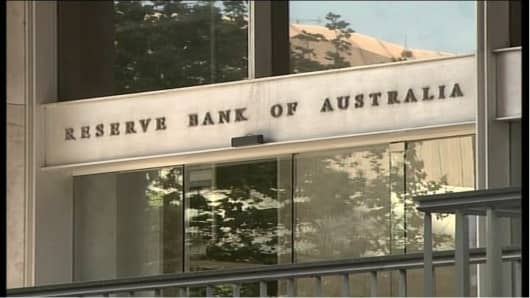Australia's central bank saw scope to cut interest rates further if needed, but felt it prudent to hold steady at its February meeting given parts of the economy were already responding to lower borrowing costs.
Yet, the Reserve Bank of Australia (RBA) also expected only modest employment growth, subdued demand for housing finance and weak investment in the non-mining sectors, minutes of its February 5 policy meeting released on Tuesday showed.
The RBA kept its cash rate unchanged at a record-low 3.0 percent, having already lowered it by 175 basis points since late 2011. This, the RBA said, had brought the average interest rate on outstanding housing loans to well below its longer-run average and only a little above its 2009 trough.
"Noting that monetary policy was already accommodative as a result of the substantial easing of policy over the past 15 months, and that this stimulus was continuing to work its way through the economy, the Board judged that it was prudent to leave the cash rate unchanged at this meeting," the minutes showed.
But "the inflation outlook, as assessed at this meeting, would afford scope to ease policy further, should that be necessary to support demand." Markets suspect rates might be cut further given softness in parts of the domestic economy, especially those exposed to foreign competition and the high local dollar. Debt markets are giving a one-in-three chance of a cut at the March 5 meeting and have fully factored in the chance of a quarter-point easing over the next 12 months.
In its quarterly report released a few days after the February 5 rate decision, the RBA trimmed its growth and inflation forecasts as a coming peak in mining investment, government spending cuts and a high currency keep economic growth below potential.
Board members were briefed on the updated staff forecasts at the meeting.
The Bank expects the economy to grow slightly below its potential at around 2.5 percent over 2013, before picking up a little over the following year.
The minutes showed that board members discussed the improving global economic backdrop, particularly for the country's single biggest export market, China. They also noted that prospects for the U.S. economy have brightened.
Board members discussed about the recent sharp rise in iron ore prices, Australia's most valuable export. However, the cost of ore had run well ahead of Chinese steel prices and might not be sustainable at such high levels.
The board noted an improvement in global financial markets, in part thanks to more aggressive policy plans by Japan's new government.
(Read More: Swan Snubs Currency War, Says Strong Aussie a Worry)
The subsequent fall in the yen had led some countries to express concerns about the strength of their currencies, though the minutes suggested little alarm at the meeting.
"The Australian dollar has appreciated by 13 percent against the yen since mid November, but there had been little change on a trade weighted basis and against the U.S. dollar," the minutes showed.


